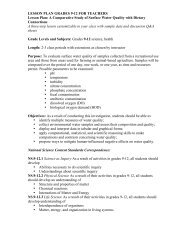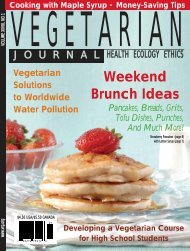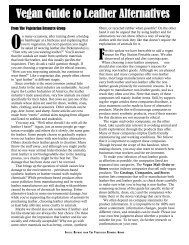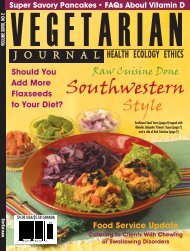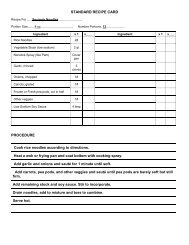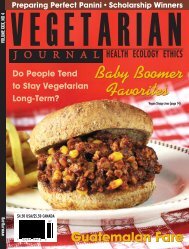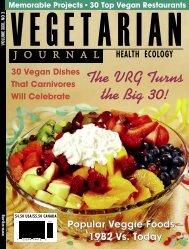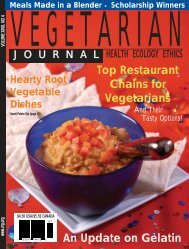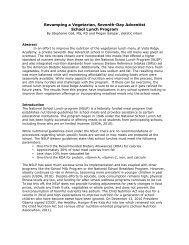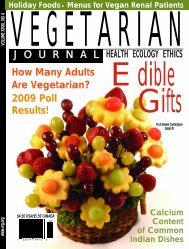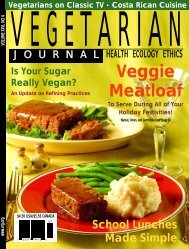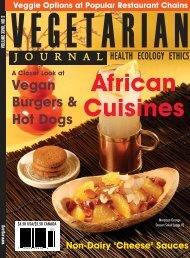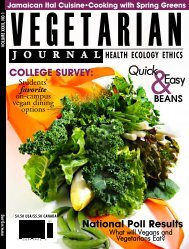Using Dried Fruit - The Vegetarian Resource Group
Using Dried Fruit - The Vegetarian Resource Group
Using Dried Fruit - The Vegetarian Resource Group
Create successful ePaper yourself
Turn your PDF publications into a flip-book with our unique Google optimized e-Paper software.
An Update on RennetBy Jeanne Yacoubou, MS, VRG Research DirectorRENNET IS DEFINED AS THE INNER LINING OF THEfourth stomach of calves and other young ruminantsor as an extract made from the stomachlining of a ruminant, used in cheesemaking to curdlemilk. Rennet also broadly refers to any enzyme usedfor the coagulation of milk in the cheesemaking process.<strong>The</strong> active component in rennet is known as rennin,the actual enzyme that causes milk to coagulate. Thisenzyme must be added to break down the proteins thatkeep milk in its liquid form. Dean Sommer, a Cheeseand Food Technologist at the Wisconsin Center forDairy Research (WCDR), estimates that 5-10 percentof the rennet is retained in the cheese curds, while therest stays in the liquid whey.Organic Valley, a major producer of organiccheeses in the United States, told us, “Historically,rennet was extracted from calf stomachs by killing thecalves, cutting the stomach into strips, scraping thelining to remove surface fat, stretching it onto racksCalf rennet is now used in lessthan 5 percent of cheese producedin the U.S., but animal-derivedlipase may be added to somecheeses with microbial rennet.where moisture is removed, grinding it, and thenfinally mixing it with a salt solution until the renninis extracted.” <strong>The</strong> rennin (also known as chymosin)was needed to coagulate milk during the cheesemakingprocess, allowing the liquid whey to be removed fromthe curds that are later pressed into cheese. Some smallcheese operations wishing to maintain tradition, especiallythose in Europe but even in the United States,still produce cheese in this manner.According to the WCDR, some people, namelytraditional cheesemakers and some artisan and specialtycheesemakers, continue to believe that calf rennet producesthe best-flavored aged cheeses, especially agedcheddar, Parmesan, and others. In fact, veal calf rennetwas once considered the “Cadillac of rennets” andsecured the highest price among all milk coagulants.Rennet is used only for making certain types ofcheese. Other dairy products, such as ice cream, sourcream, and yogurt, are not made with rennet.HISTORY OF RENNET USEIN THE UNITED STATESSteve Lutzke of Chr. Hansen, a leading enzyme company,said the supply of animal rennet was consistentlyhigh through the 1970s. Since its price was reasonable,cheesemakers had no reason to look for alternatives.Consequently, the majority of cheese produced in theUnited States at that time was made with animal rennet.According to Lutzke, the 1980s saw animal rennetsupplies become more inconsistent, resulting in pricefluctuations and even product shortages. Dave Potterof Dairy Connection, Inc., of Wisconsin, a supplier ofenzymes to many cheesemakers, attributed the declineof calf rennet use in cheesemaking and the inconsistentsupplies of the animal enzyme to the faltering vealindustry, which became more unstable in the ’70s dueto the animal protection movement. Rennet producedby microbial (specifically fungal) fermentation becamemore available. Approximately half of all rennet usedin the ’80s was microbial.By the 1990s, the animal rennet supply becameeven more inconsistent, making the price of animalrennet very high. <strong>The</strong> cheese industry had the economicincentive to transition away from animal rennet usageand so the turn toward microbially-derived rennet continuedrapidly until, by the end of the decade, almostall cheese in the U.S. was made using microbial rennet.Microbially-derived rennet was also found to be purerthan animal-derived rennet, resulting in more consistentcheese production.TYPES OF RENNETAccording to the WCDR, there are four types of rennet:calf rennet, microbial rennet, fermentation-producedchymosin, and vegetable coagulants.VEGETARIAN JOURNAL Issue Three 2008 11



